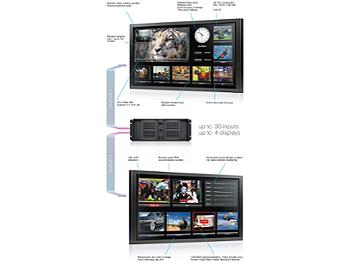Features
16 Composite video inputs (525/60 (NTSC), 625/50 (PAL), 625/50 (SECAM)).
16 analog stereo channels. One of the monitored audio channels output via computer sound card.
2 monitors (plasmas, LCD-television sets) connection via VGA / DVI / HDMI to one Stream MultiScreen device.
Video display monitor (plasma) output parameters (resolution and colour depth) are determined only by device video adaptor properties and can reach 1920x1200 pixels.
TALLY (react on shorting the relevant pair of contacts).
Random video windows position and size. The maximum size a video window can reach is the full-screen monitor size.
Video windows can overlap.
Brightness, contrast and saturation can be adjusted for every window separately.
Random audio PPM sound indicator position.
Random window text (title) location, font, size and colour.
Digital clock output with random position, font, size, colour and format of displayed data (time/date).
Each of the above mentioned objects can have a specified outline (width, colour) and background (colour or image from file (bmp, tga, tif)).
Additional features
Daily log (system operation register), which records:
o Configuration change;
o Video & Audio Loss;
o Video Frozen;
o Black Frame;
o Blocking Frame;
o GPI input change;
o Edh-errors reports for SDI-signal.
Schedule composition for response test of every alarm condition (with alarm analysis time span indication). Custom response settings for each event.
Information in the system operation register is constantly updated (and saved) in client's (operator's) application, where it is also possible to make a query from any of the system applications-servers available to obtain selective information at random system operation time range.
Upon video and/or audio signal loss computer Sound Blaster issues an alarm signal.
Quick video window location configuration change by pressing "hot keys" or according to specified schedule.
Stream MultiScreen connection to LAN allows to join several devices in a single network and fully control them from any workstation.
16 analog stereo channels. One of the monitored audio channels output via computer sound card.
2 monitors (plasmas, LCD-television sets) connection via VGA / DVI / HDMI to one Stream MultiScreen device.
Video display monitor (plasma) output parameters (resolution and colour depth) are determined only by device video adaptor properties and can reach 1920x1200 pixels.
TALLY (react on shorting the relevant pair of contacts).
Random video windows position and size. The maximum size a video window can reach is the full-screen monitor size.
Video windows can overlap.
Brightness, contrast and saturation can be adjusted for every window separately.
Random audio PPM sound indicator position.
Random window text (title) location, font, size and colour.
Digital clock output with random position, font, size, colour and format of displayed data (time/date).
Each of the above mentioned objects can have a specified outline (width, colour) and background (colour or image from file (bmp, tga, tif)).
Additional features
Daily log (system operation register), which records:
o Configuration change;
o Video & Audio Loss;
o Video Frozen;
o Black Frame;
o Blocking Frame;
o GPI input change;
o Edh-errors reports for SDI-signal.
Schedule composition for response test of every alarm condition (with alarm analysis time span indication). Custom response settings for each event.
Information in the system operation register is constantly updated (and saved) in client's (operator's) application, where it is also possible to make a query from any of the system applications-servers available to obtain selective information at random system operation time range.
Upon video and/or audio signal loss computer Sound Blaster issues an alarm signal.
Quick video window location configuration change by pressing "hot keys" or according to specified schedule.
Stream MultiScreen connection to LAN allows to join several devices in a single network and fully control them from any workstation.

